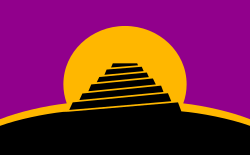
Back بوابة:لغات مصطنعة Arabic Portal:Konstruierte Sprachen German Portale:Lingue artificiali Italian Портал:Искусственные языки Russian
Introduction

A constructed language (shortened to conlang) is a language whose phonology, grammar, orthography, and vocabulary, instead of having developed naturally, are consciously devised for some purpose, which may include being devised for a work of fiction. A constructed language may also be referred to as an artificial, planned or invented language, or (in some cases) a fictional language. Planned languages (or engineered languages/engelangs) are languages that have been purposefully designed; they are the result of deliberate, controlling intervention and are thus of a form of language planning.
There are many possible reasons to create a constructed language, such as to ease human communication (see international auxiliary language and code); to give fiction or an associated constructed setting an added layer of realism; for experimentation in the fields of linguistics, cognitive science, and machine learning; for artistic creation; for fantasy role-playing games; and for language games. Some people may also make constructed languages as a hobby, or in connection to worldbuilding.
The expression planned language is sometimes used to indicate international auxiliary languages and other languages designed for actual use in human communication. Some prefer it to the adjective artificial, as this term may be perceived as pejorative. Outside Esperanto culture, the term language planning means the prescriptions given to a natural language to standardize it; in this regard, even a "natural language" may be artificial in some respects, meaning some of its words have been crafted by conscious decision. Prescriptive grammars, which date to ancient times for classical languages such as Latin and Sanskrit, are rule-based codifications of natural languages, such codifications being a middle ground between naïve natural selection and development of language and its explicit construction. The term glossopoeia is also used to mean language construction, particularly construction of artistic languages.
Conlang speakers are rare. For example, the Hungarian census of 2011 found 8,397 speakers of Esperanto, and the census of 2001 found 10 of Romanid, two each of Interlingua and Ido and one each of Idiom Neutral and Mundolinco. The Russian census of 2010 found that in Russia there were about 992 speakers of Esperanto (the 120th most common) and nine of the Esperantido Ido. (Full article...)
Selected language
Blissymbols or Blissymbolics was conceived as an ideographic writing system called Semantography consisting of several hundred basic symbols, each representing a concept, which can be composed together to generate new symbols that represent new concepts. Blissymbols differ from most of the world's major writing systems in that the characters do not correspond at all to the sounds of any spoken language.

Blissymbols was invented by Charles K. Bliss (1897–1985), born Karl Kasiel Blitz in the Austro-Hungarian city of Czernowitz (at present the Ukrainian city of Chernivtsi), which had a mixture of different nationalities that “hated each other, mainly because they spoke and thought in different languages.” Bliss graduated as a chemical engineer at the Vienna University of Technology, and joined an electronics company as a research chemist. As the German Army invaded Austria in 1938, Bliss, a Jew, was sent to the concentration camps of Dachau and Buchenwald. His German wife Claire managed to get him released, and they finally became exiles in Shanghai, where Bliss had a cousin. Bliss devised Blissymbols while a refugee at the Shanghai Ghetto and Sydney, from 1942 to 1949. He wanted to create an easy-to-learn international auxiliary language to allow communication between different linguistic communities. He was inspired by Chinese characters, with which he became familiar at Shanghai. Find out more...
Did you know...
...that J.R.R. Tolkien originally created his Middle-earth merely as a background for his constructed languages?
...that the earliest known constructed language, Lingua Ignota, was created by Hildegard of Bingen, who also acquired fame as a mystic, visionary, and composer of music?
...that Ill Bethisad is an alternate history project that features dozens of constructed languages?
Current events
(none)
Corresponding categories
Projects

|
You are invited to participate in WikiProject Constructed languages, a WikiProject dedicated to developing and improving articles about constructed languages. |
Things you can do
-
Join: Constructed Languages WikiProject & add {{Wikipedia:WikiProject Constructed languages/Userbox}}
Follow: Recent changes in related articles
Tag: {{WP conlangs}}, {{Constructed languages}}, and {{Infobox language}} (see WP:CL Templates)
Evaluate: Everything in Category:Unassessed constructed language articles
Report: Edit wars and deletions
Expand: everything in category:Constructed language stubs
Requests:
-
Abakwi, Ancient Language, Arovën, Baza, Bluddian, Dremlang, Eaiea, Eloi, Ekspreso, Esperando, Fasile, Glide, Herman Miller, Language Creation Society, Latejami, Mezhdunarodny Nauchny Yazyk, Mirad, Modern Indo-European, Mondlango, Musbrek, Noxilo, Or'zet, Romanica (rd), Romanova (rd), Signuno, Sperethiel, Szkev, Tceqli/Ceqli, Thosk, Tokcir, Troscann, Unas, UNI, Universalspråket, Vorlin.
Web resources

Some Internet resources relating to constructed languages, by Richard Kennaway
UniLang.org
Conlang wiki
Articles
Wikipedia in constructed languages
Associated Wikimedia
The following Wikimedia Foundation sister projects provide more on this subject:
-
Commons
Free media repository -
Wikibooks
Free textbooks and manuals -
Wikidata
Free knowledge base -
Wikinews
Free-content news -
Wikiquote
Collection of quotations -
Wikisource
Free-content library -
Wikiversity
Free learning tools -
Wiktionary
Dictionary and thesaurus













